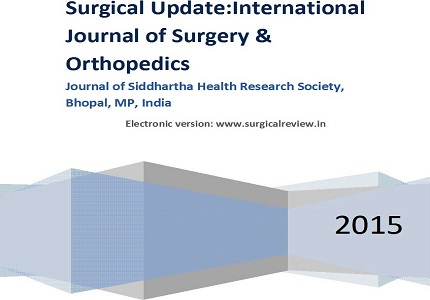Vesical calculi in children
Abstract
Vesical calculi occur due to increased urinary concentration & are commonly seen in children belonging to low socio-economic status. They are usually formed of ammonium acid urate, calcium oxalate or calcium phosphate. Vesical calculi constitute about 70% to 85% of paediatric urolithiasis & boys are affected more than girls. Primary vesical calculi occur in sterile urine & are associated with nutritional deficiency whereas Secondary calculi occur due to infection, obstruction or inflammation. Endemic calculi are associated with oxalate-rich diet. They usually present with hematuria, dysuria, frequent urinary tract infection, urinary urgency & bedwetting. The diagnostic modalities of vesical calculi are Urinalysis, urine dipstick test, serum Creatinine level, plain x-ray abdomen &Intravenous Pyelography. Sonogram is effective in identifying both radiolucent & radiopaque stones. Spiral CT scanning is highly sensitive & specific whereas Pelvic MRI orTechnetium-99m MAG-3 renal scanning yields poor resolution & are not recommended in the evaluation of bladder calculi. Treatment for vesical calculi depends on the size, composition & symptoms. The only effective medical treatment is urinary alkalization. Indications for surgery are failure of medical management, recurrent infections, acute urinary retention, suprapubic pain & significant gross hematuria. Open cystolithotomy was done earlier which is being replaced by cystolitholapaxy. With ongoing advances in instrumentation procedures like Transurethral optical litholapaxy are now applicable to children. Minimally invasive surgeries like extracorporeal lithotripsy, percutaneous nephrolithotripsy & urethroscopy have reduced open surgery to only 1- 4% of cases. Early diagnosis & appropriate management are essential for managing vesical calculi in children.
Downloads
References
2.Salah MA, Holman E, Toth C. Percutaneous suprapubiccystolithotripsy for pediatric bladder stones in a developing country. Eur Urol. 2001;39:466-70. [PubMed]
3. Grases F, Sóhnel O, Costa-Bauzá A. Renal stone formation and development. IntUrolNephrol. 1999;31(5):591-600.
4 Papatsoris AG, Varkarakis I, Dellis A, Deliveliotis C. Bladder lithiasis: from open surgery to lithotripsy. Urol Res 2006; 34(3):163-7. [PubMed]
5. V anwaeyenbergh J, Vergauwe D, Verbeeck RM. Infrared spectrometric analysis of endemic bladder stones in Niger. Eur Urol. 1995;27:154-9.
6. Rizvi, S.A. (1975) Calculous disease; a survey of 400 patients. JPMA., 25:268. [PubMed]
7. Loutfi, A.H. Vesicallithiasis; etiology and management, in idiopathic urinary bladder stone disease. Sponsored by John E. Fogurty International Center.Edited by Robert Van Reen. Washington, DHEW Publication, 1977, p. 335.
8. Singh, S.M. Idiopathic urinary bladder stone disease in India; historical aspects, geographical incidence, and clinical features, in idiopathic urinary bladder stone disease. Sponsored by John E. Fogarty International Center.Edited by Robert Van Reen. Washington, DHEW Publication, 1977, p. 209.
9. Van Reen, R. Geographical and nutritional aspects of endemic stones, in urinary calculus international urinary stone conference. Edited by J. Gwynne Brockis and Birdwell Finlayson. Littleton, PSG Publishing, 1981, p.177.
10. Finlayson, B. Where and how does urinary stone disease start? An essay on the expectation on free-and fixed-particle urinary stone disease, in idiopathic urinary bladder stone disease.Sponsored by John E. Fogarty International Center.Edited by Robert Van Reen. Washington, DHEW Publication. 1977, p.7.
11. Qureshi K, Oakley N, Hastie K. Management of urinary tract calculi. Surgery International, 2003;60:285-90.
12. Menon M, Resnick MI. Urinary lithiasis: etiology, diagnosis, and medical management. In: Walsh PC, Retik AB, Vaughan ED, Wein AJ, editors. Campell's urology. 8th ed. Philadelphia: Saunders Elvesier; 2004. p.3229.
13. Bartel P, Krebs J, Wöllner J, Göcking K, Pannek J. Bladder stones in patients with spinal cord injury: a long-term study. Spinal Cord. 2014 Apr. 52(4):295-7. [PubMed]
14. Ho K, Segura J. Lower Urinary Tract Calculi. Wein A, Kavoussi L, Novick A, PartinA, Peters C. Campbell-Walsh Urology. 9th. Philadelphia, Pa: Saunders Elsevier; 2007. 3: 2663-73.
15.El Gohary MA, Cook RC. Vesical calculi in children in Kuwait; Progress in Pediatric Surgery.1982, 15:243-254.
16. Perrone HC, Koch VH. Nefrolitíasenainfância. In: Barata HS, Carvalhal GF. Urologia: princípios e prática. Porto Alegre: Artmed; 1999.p.573-7.
17. Mshelbwala PM, Ameh EA, Mbibu HN. Urinary stones in children. Nigerian J Surg Res 2005; 7: 238-43.
18. Neulander E, Kaneti J. Posterior urethral valves and vesicolithiasis in children. IntUrolNephrol 1996;28:563-8. [PubMed]
19. HimanshuAcharya, N. P. Dhende, S. B. Mane, Abu Obaidah. Posterior urethral valves with vesical calculus: A rare Association; J Indian AssocPediatrSurg / Jul-Sep 2009 / Vol 14 / Issue 3. DOI: 10.4103/0971-9261.57705. [PubMed]
20. Ho K, Segura J. Lower Urinary Tract Calculi. Wein A, Kavoussi L, Novick A, PartinA, Peters C. Campbell-Walsh Urology. 9th. Philadelphia, Pa: Saunders Elsevier; 2007. 3: 2663-73.
21. Huang WC, Yang JM. Sonographic appearance of a bladder calculus secondary to a suture from a bladder neck suspension. J Ultrasound Med. 2002 Nov. 21(11):1303-5.
22. Cohen TD, Ehreth J, King LR, Preminger GM. Pediatricurolithiasis: medical and surgical management. Urology 1996; 47:292-303. [PubMed]
23. Bigelow HJ. Lithotrity- a single operation: Boston Med Surg J 1879; 98: 259-91.
24. Maheshwari PN, Oswal AT, Bansal M. Percutaneous cystolithotomy for vesicle calculi: a better approach.Tech Urol 1999; 5: 40-2. [PubMed]
25. Bapat SS. Endoscopic removal of bladder stones in adults. Br J Urol. 1977 Nov. 49(6):527-30.
26. Shokeir AA. Transurethral cystolitholapaxy in children.J Endourol. 1994 Apr. 8(2):157-9; discussion 159-60.
27. Marberger M, Hofbauer J. Ureteroscopy/nephroscopy and percutaneous stone procedure. In: Smith AD, Baldlani GH, Bagley DH, Clayman RV, Jordan GH, Kavoussi LR, et al., editors. Smith’s textbook of endourology. St Louis (MO): Quality Medical Publishing; 1996.p.1406-26.
28. Nazar Ali Memon, Jan MuhammedMemon, Syed QaiserHussainNaqvi, Shafiq-u-RahmanMemon. Percutaneous use of stone punch in the management of vesical calculi in children: a new treatment modality; Gomal Journal of Medical Sciences Jan–June, 2006, Vol.4, No.1.
29. Wollin TA, Singal RK, Whelan T, Dicecco R, Razvi HA, Denstedt JD. Percutaneous suprapubiccystolithotripsy for treatment of large bladder calculi.J Endourol. 1999 Dec. 13(10):739-44.
30. Zhaowu Z, Xiwen, Fenling Z. Experience with electrohydraulic shockwave lithotripsy in the treatment of vesical calculi. Br J Urol 1988;61:498-500.

Copyright (c) 2015 Author (s). Published by Siddharth Health Research and Social Welfare Society

This work is licensed under a Creative Commons Attribution 4.0 International License.


 OAI - Open Archives Initiative
OAI - Open Archives Initiative


















 Therapoid
Therapoid

